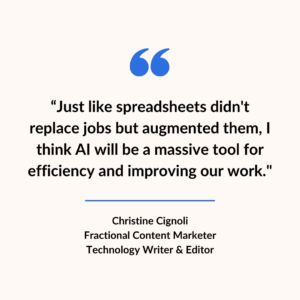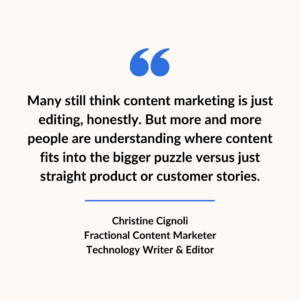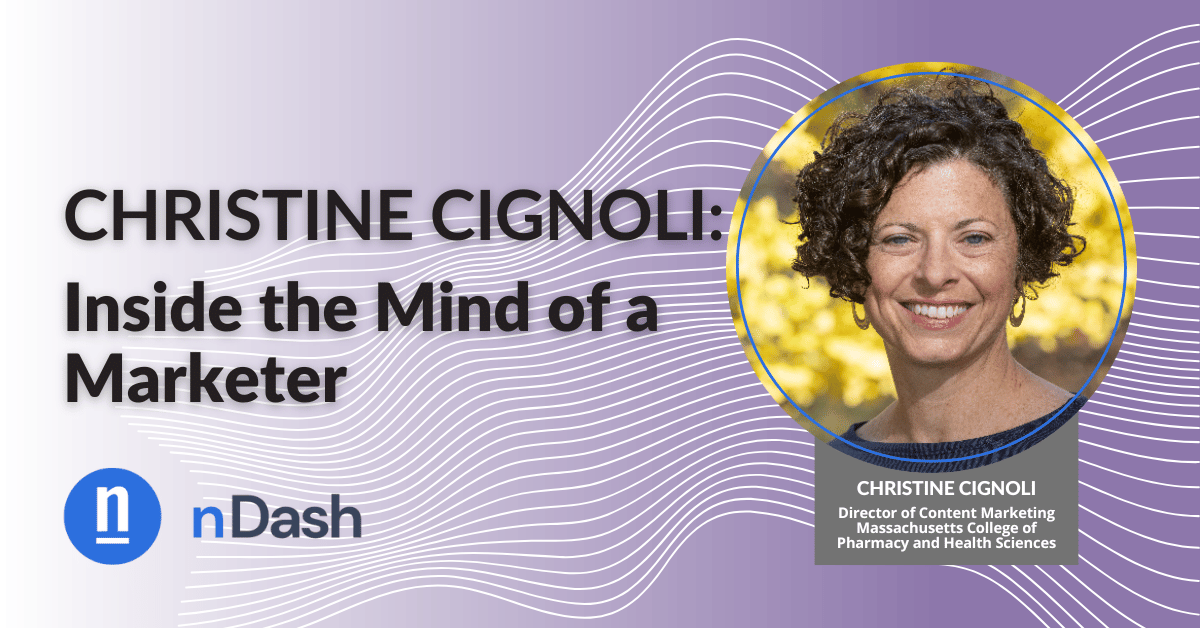We’re back with another marketer interview as part of our “Inside the Mind of a Marketer” series. This time, we’re talking to Christine Cignoli, a Fractional Content Marketer. She’s discussing her background as a marketer and about all things content marketing.
nDash’s Interview with Christine
 Matt: I have a whole bunch of questions I could ask you, especially given your experience at Google Cloud. Given your work as a marketer, are there any hot topics you want to chat about?
Matt: I have a whole bunch of questions I could ask you, especially given your experience at Google Cloud. Given your work as a marketer, are there any hot topics you want to chat about?
Christine: I mean, I’m always interested in where content marketing has been, where it is, and where it’s going. I’m always interested in talking about where we’ve been and what’s next because it’s already grown so much in the past 15 years. When I started working in content marketing at SimpliVity, my first job in marketing that it’s been taken a lot more seriously over time. There was always product marketing, customer marketing, and event marketing, and now content has a seat at the table. More leaders think it’s a must-have than a nice-to-have.
Many still think content marketing is just editing, honestly. But more and more people are understanding where content fits into the bigger puzzle versus just straight product or customer stories.
Matt: Do you think leaders just think of it as tied to Google or SEO? Or do you think they’re starting to appreciate that there’s more value throughout the funnel? For educational content?
Christine: Yes, exactly. I definitely see more leaders really investing in thought leadership, using channels like Forbes BrandVoice, CIO.com, and their own channels for thought leadership. It’s more of the full funnel than just SEO because you’re right—that’s another piece of it that people used to think was just editing or copying in-product messaging.
Matt: I’ve always divided them into two different positions. SEO is like writing for the Google bots of the world, and content marketing is writing for the actual people reading the content. These are completely different channels.
Christine: Yes, that’s definitely part of it. There’s SEO in content marketing, SEO, and then technical SEO, which I see broken up more into the backend. In content marketing, you’re making sure SEO is naturally incorporated into your content.
Matt: How does content marketing differ at smaller companies from something like [working at] Google Cloud? Did your metrics and goals change, or did some of those traditional metrics carry over from one to the next?
Christine: When I first started, we looked at a lot of the traditional metrics. But at my next job, the content team was new, and the company was small, so every day, my goal was, “What can I create today?” If I found a Post-it note on the ground, I’d think, “What can I make it into?” Someone would mention SD-WAN, and I’d ask them for more: “What is that? What can we write about that?”
It was such a one-woman show that it was just create, create, create. Then, when I worked at Google Cloud, that’s thousands of people, just a massive number of smart people working on databases alone. It went from scrappily putting together content to having all this existing content and potential content and trying to make sense of it to shape it into something more cohesive to tell a story.
Matt: How do you write content when there are no taillights to follow? Like at Google, where it feels like so much content has already been covered?
Christine: At Google, there was never an end to how much you could cover—in the best possible way. You could never cover it all. I really enjoy the feeling that we could talk about this one product all day. And that was just one database when there were multiple databases multiplied by however many people dedicated to that. There’s just an endless supply of angles and topics. We did fun anniversary stuff, like “How I built it” for the analytics product, which was really fun.
Matt: And then the second part of my question. Did you have to write one piece of content and then figure out ways to write that for different audiences? Or was it consistently the engineer that you were writing to?
Christine: It was different; it expanded. When I started, it was mainly the engineer, but to be authentic, you need to include different levels of technical detail depending on the audience. We did a lot of Forbes BrandVoice work there, and I wrote about database technology for that audience.
But it’s not so different because those readers were engineers themselves at some point. It’s about making sure to include the right level of detail, whether it’s more about business decisions or technical business decisions. It’s keeping in mind that these audiences are teammates; they work together, and they want to know what their teammates are working on and what the hot topics are.
Matt: How do you incorporate that as a writer?
Christine: For thought leadership, it’s always making sure to include technical details and a point of view. You can’t just have a thought; you have to have a point of view. If someone presents a thought leadership idea, the first question is, “What’s the thought?” If the answer is “You should buy our product,” that’s not a thought. The thought is something like “Managed databases are better than proprietary databases.”
Then follow that where it leads. At TechTarget, we did a series on how to make business decisions. For engineers, it might be how to convince their boss you need to invest in a new product, or for an executive, what their teams need from technology right now to make their jobs easier. It’s about ensuring there’s fluidity, that you’re not just focusing on one audience but considering how different audiences interact and what they need to know from each other.
Matt: So you mentioned efficiencies in content marketing. As a marketer, what are your thoughts on AI in this field?
Christine: I might just be delusional, but I think there’s just so much that a human does in writing and editing content that AI can replace.
At my last job, we played around with AI as a tool to overcome writer’s block or when writing the same type of headline all the time. It was nice to see what AI suggested to get out of a rut. Organizing large amounts of information is also a good use for AI, like when you’re drafting an outline, and you’ve got a huge pile of notes and data to sort through.
You have to ask the right questions to AI. I don’t think we’re going to be replaced by robots anytime soon.
 Matt: I share a similar sentiment. I think AI is really powerful, and there will be some diminishing returns on progress. For example, going from version one to two might be massive leaps and bounds. But as you get further along, the improvements might be less dramatic. It’s like when spreadsheets first came out. It was mind-blowing for those who were used to doing everything manually.
Matt: I share a similar sentiment. I think AI is really powerful, and there will be some diminishing returns on progress. For example, going from version one to two might be massive leaps and bounds. But as you get further along, the improvements might be less dramatic. It’s like when spreadsheets first came out. It was mind-blowing for those who were used to doing everything manually.
Christine: Can you imagine? And AI is so much more powerful than that leap was. But for me, that’s a massive tool that will fundamentally change how we work. Just like spreadsheets didn’t replace jobs but augmented them, I think AI will be a massive tool for efficiency and improving our work.
Matt: From the perspective of a marketer, how has your content strategy evolved over the last roles you’ve had? I feel like a lot of content marketers these days get pigeonholed into specific topics. But you’ve managed to work across various verticals and company sizes.
Christine: It’s always coming back to content enablement first, helping teammates and stakeholders understand what a content marketing team can do for them. I like to show examples because I’ve often worked with very technical people who hadn’t worked with a content marketing team before. I’d suggest creating an ebook or something similar to reach different audience levels—like tech execs or architects—and they’d sometimes suggest just copying and pasting documentation.
So it was important to show them what I meant by different content types, like what an infographic might look like, and then how to build a content calendar out around that. It’s almost over-communicating what specific content strategies or pieces mean because the field is still emerging, and people often have varying understandings of what content marketing involves.
Matt: As a marketer, how does content distribution fit into your strategy? Is distribution considered separately, or is it an integral part of your planning?
Christine: Absolutely integral. A lot of my role, especially in past jobs, wasn’t just creating new content but also optimizing and repurposing what already existed. It’s about planning not just to publish but to keep reusing content effectively. We’d plan to post certain pieces on social media regularly, use different introductions, and ensure that we’re continuously engaging our audience. It’s about making sure that good content doesn’t just sit there but reaches as many relevant viewers as possible through various channels and approaches.
Matt: How do you see AI impacting content creation? It seems, at least perception-wise, to be shifting toward distribution rather than just creation. Is this a chicken-or-the-egg situation?
Christine: Definitely. The shift towards distribution is crucial because you can have great content. But if it’s not reaching the right people at the right time, it’s not doing its job. Content strategy isn’t always about creating new content. Often, it’s about making the most of what you already have. This involves strategic distribution—deciding where and when to share content to maximize impact.
For example, we might decide to republish a piece with a new introduction or share it on different platforms periodically. Also, aligning content to publish or repromote alongside events or using it to complement other marketing efforts really matters.
 Want to learn more about Christine Cignoli, her background as a marketer, or her writing experience? Hire her on nDash or check out her LinkedIn profile to connect or learn more about her experience and other content musings. Or, visit her nDash profile: Christine Cignoli: Writer & editor for tech, healthcare, finance & education.
Want to learn more about Christine Cignoli, her background as a marketer, or her writing experience? Hire her on nDash or check out her LinkedIn profile to connect or learn more about her experience and other content musings. Or, visit her nDash profile: Christine Cignoli: Writer & editor for tech, healthcare, finance & education.
